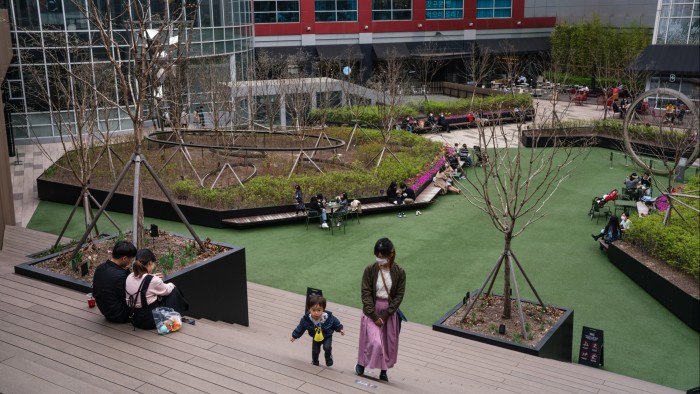Career or family? The dilemma facing women in South Korea

Roula Khalaf, Editor of the FT, selects her favourite stories in this weekly newsletter.
Yoon Yoo-rim was an office worker in South Korea until six years ago, when she informed her employer she was pregnant. “As soon as I told them,” she says, “they hired a young man as my replacement.”
Yoon now works from home writing digital comics — webtoons — and taking care of her five-year-old daughter. She would probably have quit her job in overseas sales once she had a family anyway, she says, because of the long hours and company dinner and drinking sessions.
“My female colleagues also found it impossible to continue to work without full support from their parents or in-laws for childcare,” she says.
Faced with this economic and cultural discrimination, which can mean they take on most chores at home, many South Korean women seem reluctant to marry or have children: the country has the world’s lowest fertility rate, of 0.72 children per woman of childbearing age. The result is an ageing population and an emerging demographic crisis.
In response, the government has been spending big to counter this low birth rate, with Won380tn ($286bn) committed since 2006 to make childcare more affordable, expand paid parental leave, and encourage reduced working hours.
It plans to increase parental leave from 12 to 18 months, has tripled monthly allowances for childcare, and has expanded subsidies for small businesses that allow flexibility for working mothers. A pilot scheme to let 100 Filipino workers come to Seoul to help with domestic tasks could also be launched as early as June.
More stories from this report
And many big Korean companies are now permitting more flexible working.
Hwang Ji-Yeon, a 37-year-old office worker for South Korean steelmaker Posco, who has a young school-age son, is one beneficiary of the move. She works from home four hours every weekday morning because the company allows flexible work arrangements for parents, for up to two years per child.
“I am very lucky as not many Korean companies allow this level of flexibility,” says Hwang. “It would have been very difficult to juggle demands at work and home if remote work was not allowed.”
For her, flexible working allows reduced hours rather than the potential alternative of no hours at all.
Women staying in work is essential for the economy, says Park Yoon-soo, economics professor at Sookmyung Women’s University in Seoul. “The problem is that social structure, including the work environment, makes it difficult for women to balance work and family life — so many of them are forced to choose one or the other.”
According to IMF research, South Korea could increase its per capita income by 18 per cent if it narrowed its gender gap in hours worked to the average across peer countries.
But improvements are incremental, and gender gaps are not closing fast.
South Korea has the highest gender pay gap among rich countries, with women paid a third less than men, despite their above-average level of tertiary education, reports the OECD. Women’s labour force participation in the country has increased — from 49.8 per cent in 2011 to 55.6 per cent last year — but it is still 18 per cent lower than men’s, according to the national statistics body.
The rigid corporate culture and working hours — some of the longest among OECD nations — remain a barrier to women’s labour participation. More than 40 per cent of South Korean women take an extended career break after marriage and childbirth, while those who stay in work struggle to progress their careers.
“Even in the financial sector, which has many female workers, there are few female board members,” observes Kim Nan-joo, a researcher at the Korean Women’s Development Institute, a research institution.
Still, Korea’s work culture and societal attitudes to women are slowly improving, thanks to the country’s strong #MeToo movement, growing outcry over digital sex crimes and violence against women, and young people’s resistance to the longer working week.
The number of female board members at the country’s top 100 companies rose from 5.2 per cent in 2020 to 15.9 per cent last year, according to headhunter Unicosearch, after the government banned single-gender boards at companies with assets of more than Won2tn.
However, about 80 per cent of jobs in South Korea are in smaller businesses, where policy measures to support working mothers “are not well implemented”, notes Bae Jin-kyung, head of the Korean Women Workers Association, an advocacy group. “In the end, it is a matter of culture. Cultural changes are being made, but too slowly.”
Bae also warns that offering more flexible working only to women would exacerbate the gendered division of labour at work and at home, where women already spend three times more time on domestic work and childcare than men, according to a government survey. “Women face a double burden because they have to become primary caregivers while also working,” says Bae.
Yoon is a case in point. “My workload is not small, and I earn as much as my husband, but people take it for granted that I bear the brunt of childcare and household duties just because I work from home,” she says.
“Social support for childcare should be equally provided for men . . . otherwise, the vicious circle will continue.”

Comments